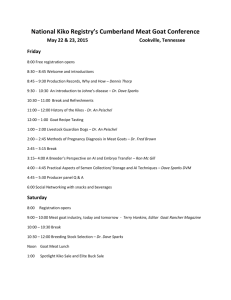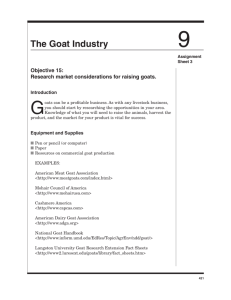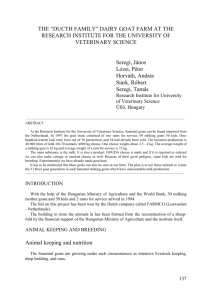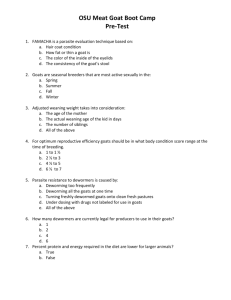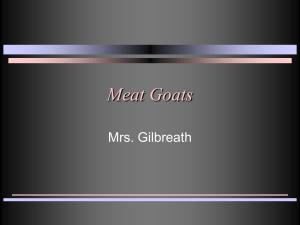Raising Meat Goats
advertisement
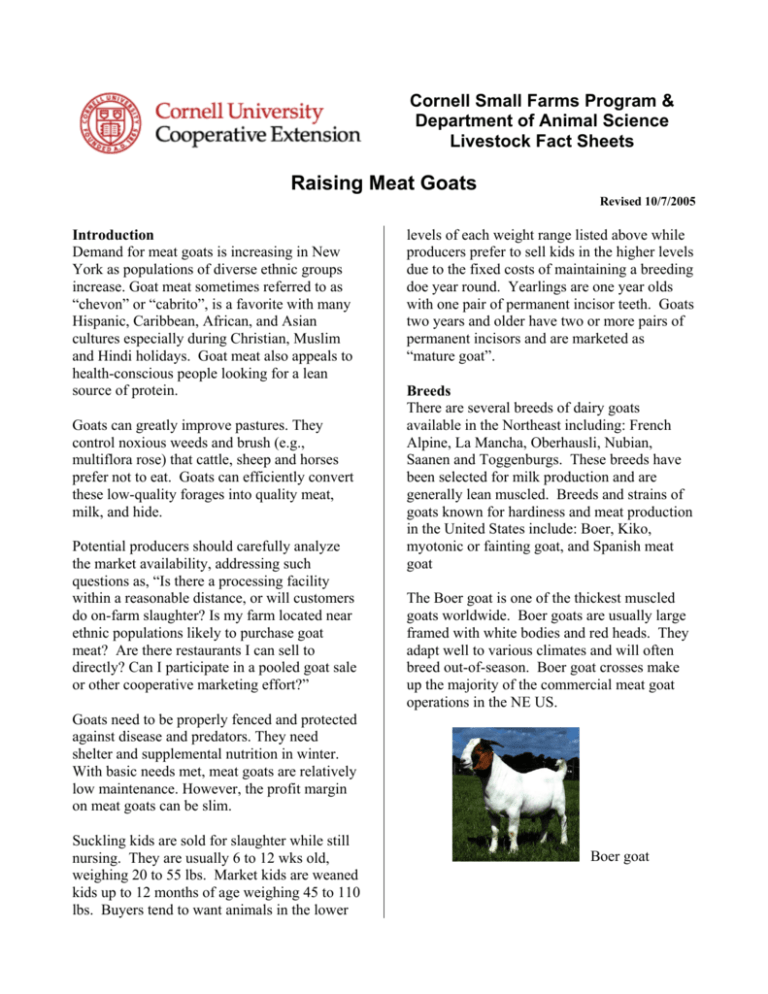
Cornell Small Farms Program & Department of Animal Science Livestock Fact Sheets Raising Meat Goats Revised 10/7/2005 Introduction Demand for meat goats is increasing in New York as populations of diverse ethnic groups increase. Goat meat sometimes referred to as “chevon” or “cabrito”, is a favorite with many Hispanic, Caribbean, African, and Asian cultures especially during Christian, Muslim and Hindi holidays. Goat meat also appeals to health-conscious people looking for a lean source of protein. Goats can greatly improve pastures. They control noxious weeds and brush (e.g., multiflora rose) that cattle, sheep and horses prefer not to eat. Goats can efficiently convert these low-quality forages into quality meat, milk, and hide. Potential producers should carefully analyze the market availability, addressing such questions as, “Is there a processing facility within a reasonable distance, or will customers do on-farm slaughter? Is my farm located near ethnic populations likely to purchase goat meat? Are there restaurants I can sell to directly? Can I participate in a pooled goat sale or other cooperative marketing effort?” levels of each weight range listed above while producers prefer to sell kids in the higher levels due to the fixed costs of maintaining a breeding doe year round. Yearlings are one year olds with one pair of permanent incisor teeth. Goats two years and older have two or more pairs of permanent incisors and are marketed as “mature goat”. Breeds There are several breeds of dairy goats available in the Northeast including: French Alpine, La Mancha, Oberhausli, Nubian, Saanen and Toggenburgs. These breeds have been selected for milk production and are generally lean muscled. Breeds and strains of goats known for hardiness and meat production in the United States include: Boer, Kiko, myotonic or fainting goat, and Spanish meat goat The Boer goat is one of the thickest muscled goats worldwide. Boer goats are usually large framed with white bodies and red heads. They adapt well to various climates and will often breed out-of-season. Boer goat crosses make up the majority of the commercial meat goat operations in the NE US. Goats need to be properly fenced and protected against disease and predators. They need shelter and supplemental nutrition in winter. With basic needs met, meat goats are relatively low maintenance. However, the profit margin on meat goats can be slim. Suckling kids are sold for slaughter while still nursing. They are usually 6 to 12 wks old, weighing 20 to 55 lbs. Market kids are weaned kids up to 12 months of age weighing 45 to 110 lbs. Buyers tend to want animals in the lower Boer goat The Kiko is also a large framed goat and is commonly white. It is known for hardiness and excellent mothering ability. Kiko doe and kid Feed Requirements Goats will consume a wide range of grasses, legumes and browse. Browse plants include brambles, shrubs, trees, and vines with woody stems. Because of their tapered muzzles and mobile upper lips, goats are selective eaters able to choose the most nutritious plant parts. They eat both grasses and small forbs but generally prefer browsing brush over grazing pastures. They thrive on both but are more susceptible to internal parasites when grazing the short canopy of conventional pastures. Producers should extend the grazing season as long as sufficient nutrition is available to maintain acceptable body weight and growth. A good strategy for herds raising market kids is to time kidding to occur in April just before the pasture growing season when ample forage will become available for lactating does and growing kids. This decreases the need for expensive high quality harvested feed in the winter. Herds marketing suckling kids to meet the increased Easter demand must kid during winter and thus do not have this option. They must obtain a substantially higher price per lb live weight to cover their additional costs of production. Stocking rates of goats on pasture will vary with animal type and pasture quality. As a general guideline, 6 to 8 or 9 to 11 goats will equal one cow on good quality pasture or good brush-browse system, respectively. Pasture capacity may be limited by parasite load more than available forage. In winter, producers will need to provide hay. Goats are very susceptible to listeria and baleage and silage should be fed with extreme caution. Growing kids, lactating or pregnant does will generally require additional protein and energy in the form of concentrates. Facilities Good fencing of the land is essential in goat production. Producers can opt for tightly woven wire with barbed wire above the woven wire and at ground level, or for electrified hightensile fencing. Six-strand high-tensile fence is effective with goats. Often, the lowest strand is not electrified. Weed control along fences may be needed to keep them from shorting out. Electrified netting, a prefabricated lightweight mesh fence, can be used for short term grazing periods and easily moved to rotate animals around the farm. Netting is not good to use with animals that have horns because they can become entangled and die. Goats will seek shelter from rain, wind and cold. A south-facing 3-sided shed will provide nighttime and rain shelter for goats; producers should allow 12-15 square feet per animal. For winter shelter in a barn or other structure, 25-30 square feet per goat is recommended (e.g., an area 20 ft by 20 ft can house 13-16 head of goats) A draft free barn with good ventilation is a must for herds kidding during the winter. Producers should devise chute and alley systems with herd size in mind—the larger the herd, the more elaborate the handling facilities will generally be. A catch pen, at least four feet tall, should be incorporated in the system for sorting and handling animals and to serve as a station for deworming, hoof trimming, and vaccinations. Producers who plan to offer onfarm slaughter to customers should provide a dressing station equipped with working surfaces, hooks and ropes, and running water. Handling and Labor Requirements I. Health The goat herd should be vaccinated against enterotoxemia (overeating disease) and tetanus. Adult breeding males should be vaccinated once a year, while females should be vaccinated 4 to 6 weeks before kidding, so that immunity is transferred through the colostrum to the kids. Kids should be vaccinated against enterotoxemia and tetanus at 8 weeks of age, followed by a booster at 12 weeks. Consult your veterinarian for vaccination protocols. Goats are very susceptible to internal parasites. Your veterinarian can help you plan a control program combining key management practices with fecal egg monitoring and strategic deworming. Awareness for goat and guard llama owners should be given for the parasite P. tetnus. This parasite is picked up from snails on moist, wet pastures and will paralyze affected animals. Goat gestation averages 150 days. Breeding occurs in the fall (Sept through Nov) for spring kidding. Does come into estrus, or heat, every 21 days during the breeding season. Generally, one mature buck services 25 does. Producers should expect to be busier in the springtime when does start kidding. A normal healthy goat has a rectal temperature of 102 to 103 F, 12 to 15 breaths per minute, and a heart rate of 70 to 80 beats per minute. In general, kids will have a slightly higher temperature and faster heart rate and respiration. II. Management Goat kids can be weaned at 10 to 12 weeks of age. Farms kidding only once per year often opt to run the kids with the does for a longer period of time. However, buck kids can become fertile by 3 to 4 months of age and should be castrated at an early age if left in the herd. Producers should frequently observe weaned kids. Weaning is a stressful time when coccidia parasites may increase sharply in kids. Kids showing signs of coccidia are at risk of dehydration and death. Consult your veterinarian for coccidia control. Castration should be performed on all buck kids not being kept as future herd sires. An exception is buck kids that are marketed prior to reaching puberty. Castration can be done by using an elastrator (heavy rubber rings) on the scrotum, by using a Burdizzo clamp above the testicles, or by manual removal of testicles with a disinfected sharp knife. Different methods are appropriate at different ages. Producers may opt to prevent horns from growing on kids by disbudding them (burning horn buds with an iron rod) at 3 days to 2 weeks of age. Hornless goats are easier to manage and less likely to injury other goats or people. You can learn various management skills from other goat owners, veterinarians or extension field days. Cornell Goat Specialist Dr. tatiana Stanton 132 Morrison Hall Cornell University Ithaca, NY 14853 607-254-6024 tls7@cornell.edu Small Ruminant Marketing Listserve, SRMARKETINGL. To subscribe, send a message to listproc@cornell.edu, with the subject line blank. In the body of the message put subscribe smarketing-L Firstname Lastname, where "Firstname Lastname" is your real name. Reproductive Statistics for Goats FEMALE Age of puberty 7 to 10 months Breeding weight 60 to 75% of adult weight Estrous cycle Length 18 to 22 days Duration 12 to 36 hours Signs Tail wagging, mounting, bleating Ovulation 12 to 36 hrs from onset of standing heat Gestation length 146 to 155 days Breeding season August-January Seasonal anestrous February-July MALE Age of puberty 4 to 8 months Breeding age 8 to 10 months Breeding season All year Breeding ratio 1 buck : 20 to 30 does Adapted from: Dr. Jean-Marie Luginbuhl, Extension Meat Goat Specialist, North Carolina State University. Level of Skill Pros: ¾ High and growing demand for product ¾ Lower initial investment than larger livestock species ¾ Vegetation control/ability to improve pastures for other livestock ¾ Easy to handle, small size ¾ ¾ Flexible labor Market available for all size and age animals if marketed during specific times of the year. Cons: ¾ ¾ Harder to contain/require tight fencing Marketing niche requires more effort to establish ¾ Susceptible to parasites ¾ Susceptible to predators ¾ Offensive odor from bucks Animal Source To locate meat goat animal suppliers in NY State go to: Empire State Meat Goat Producers Association. They are also an excellent source for support. http://www.esmgpa.org Market Availability Meat goats can be marketed right off the farm directly to consumers, through established auction barns or through pooled animal sales. Each market has pros and cons. Talk with other local goat producers to find the best markets for your area. Sheep and Goat Marketing Program, run through Cornell University offers educational and marketing opportunities to meat goat producers. http://www.sheepgoatmarketing.info/ Budget for Does kidding once / year in the spring Income amount/doe Kids sold per doe 1.5 kids@ 80 lbs x $1.00/lb Cull does (15% herd/yr) 125 lbs x $0.50/lb .15/yr/doe Gross income/doe Expenses General estimate $120.00 ____________ $9.38 $129.38 ____________ ____________ $16.00 $13.50 $15.75 _____________ _____________ _____________ (includes feed for doe & kids) Salt and minerals, 11 lbs x $0.30/lb Veterinary medications Buildings and fences Marketing and hauling Vehicle, fuel, utilities, etc Operating cost/doe $3.30 $15.00 $10.00 $5.00 $10.00 $88.55 _____________ _____________ _____________ _____________ _____________ _____________ Net receipts/doe $40.83 _____________ Hay (400 lbs x $80/ton) Legume Hay (225 lbs x $120/ton) Grain (225 lbs x $140/ton) Your estimate For More Information Small Farms Program 135c Plant Science Building Cornell University, Ithaca, NY 14853 www.smallfarms.cornell.edu Sheep and Goat Marketing Program http://www.sheepgoatmarketing.info/ ATTRA Appropriate Technology Transfer for Rural Areas, P.O. Box 3657, Fayetteville, AR 72702 http://www.attra.org/livestock.html University of Maryland – National Goat Handbook http://www.inform.umd.edu/EdRes/Topic/AgrEnv/ndd/ goat/ Maryland Small Ruminant Page www.sheepandgoat.com American Boer Goat Association Phone: 325-486-2242 http://www.abga.org/ American Meat Goat Association P.O. Box 1321 Sonora, TX 76950 Phone: 915-387-6100 American Kiko Goat Association P.O. Box 531 Gordonsville, VA. 22942 Phone: (540)967-5380 Livestock Fact Sheet series developed with grant funds provided by Cornell Small Farm Program Prepared by Martha A Wright, MS, PAS, Extension Educator, Department of Animal Science, Cornell University Cornell Cooperative Extension provides equal program and employment opportunities.

